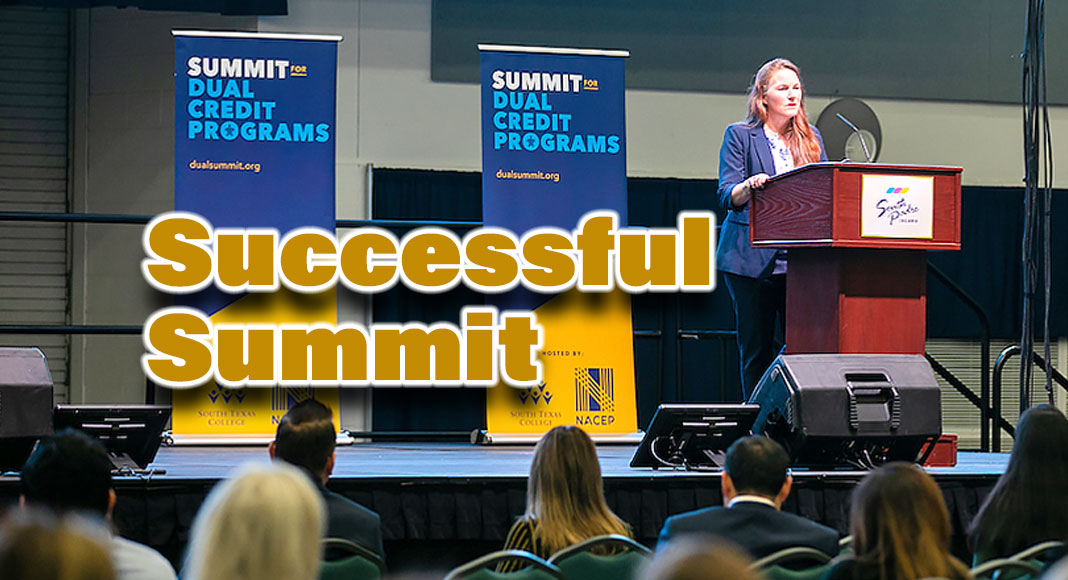
Texas Border Business
By Amanda Sotelo
South Texas College is a national leader in dual credit programs and as the only college in the state that is accredited by the National Alliance of Concurrent Enrollment Partnerships (NACEP), STC has the honor of hosting the Dual Credit Summit, the only other event outside NACEP’s national conference that tells the success stories of dual credit.
This is the third consecutive year that STC hosts the summit, but it’s only the second time that more than 300 dual credit professionals and advocates, representing 28 states from across the country, gather at the South Padre Island Convention Center for an in-person event.
“This is a milestone for South Texas College,” said Dean of Dual Credit Programs and School District Partnerships Rebecca De Leon, Ph.D. “Being able to come together, address challenges, focus on best practices and structures and how put them in place is the key to this summit.”
With college readiness and a decrease in student engagement being common challenges faced by school districts and institutes of higher education, the two-day event featured keynote speakers President and Chief Executive Officer for Institute for Evidence-Based Change Brad C. Phillips, Ph.D. and Aerospace Engineer and Former NASA rocket scientist Shayla Rivera and presenters that focused on topics such as telling the dual enrollment story, improving student success, enhancing partnerships, leadership in dual enrollment and how to break barriers for educational access.
Among those conversations, Phillips shared his story about being a dual credit alumnus and how it changed his life trajectory.
“There’s a lot behind my experience, but bottom line is I did not enjoy high school,” he said. “But one of my counselors, back in the day before dual credit was even a thing, introduced me to the opportunity of Education Participation in the Community (EPIC), or what they now call dual credit, and everything changed. I got excited about education.”
Fast forward, Phillips, a first-generation college graduate, now holds a Ph.D. in Psychology, is a published author and helps educators develop new and innovative ways to improve education using evidenced-based solutions.
“My goal is to always empower people, educators, with simple techniques that help them get their message across through the use of data and to engage for a call to action,” said Phillips. “There are so many students, and my story is an example of that, who want to improve their lives and dual enrollment is one of the ways to have that opportunity and to see what they can do, can be and essentially escape poverty and change the course of their lives. These are also the stories we must tell.”
Meanwhile, Rivera inspired the crowd with her story of education, resiliency and strength through loss, self-reflection and self-discovery.
“We evolve, change and move constantly,” she said. “We can do the impossible…jump as high as we can without setting limits or putting a lid on our jars. Take fleas for example, they’re so tiny, yet jump so high, but if they were in a jar, with the lid on, they would only ever jump as high as the lid. This is what we have to inadvertently stop doing to ourselves and the ones we love…we just need to go out there and do it.”
Although dual credit is changing lives, a common issue among those in attendance and one also touched on by STC President Ricardo J. Solis is the lack of engagement that is still being seen from students since the beginning of the pandemic in 2020.
“This summit is a significant event, it reinforces what is needed now for our students and what we’re already doing,” said Solis. “Right now, we are seeing a downturn in college enrollment throughout the nation, but it’s also a time when you need to have higher education credentials and this event is a response to that need.”
He added, “We all know the importance of dual enrollment, it’s an equalizer, impacts regional economies and sets the stage for further education. Dual enrollment is an accelerator.”
Executive Director of the National Alliance of Concurrent Enrollment Partnerships Amy Williams said she is thrilled that three years ago STC took the initiative to host this summit, which has now become an annual tradition.
“Our goal is to grow within this collaboration with South Texas College,” said Williams. “This summit allows us to add more to our national voice and helps us expand our work across the nation. Dual enrollment programs survive and thrive when it is founded in the element of partnership, and this allows us to come together and support each other’s initiatives and programs.”
The STC Dual Credit Program serves 21 partnering school districts in Hidalgo and Starr counties and offers pathways towards core curriculum completion; certificates in career and technical education programs such as welding and associate degrees in academy programs such as business, criminal justice or science, technology, engineering and mathematics (STEM).
To date, STC has saved it’s partnering school districts, students and families more than $340 million.
For information on STC’s Dual Credit Programs, visit https://www.southtexascollege.edu/dual/















